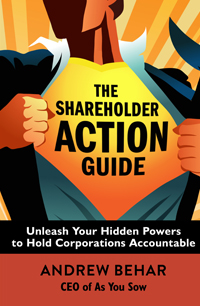We are grateful to Andrew Behar, CEO of As You Sow, who has shared this excerpt from his 2016 book, The Shareholder Action Guide, for our series remembering Fr. Mike Crosby and fifty years of SGI.
It goes without saying that a chorus requires more than one voice, so allying yourself with an existing community of like-minded people has obvious advantages. For years, churches and faith-based organizations have been very active in issues of social justice, and those issues have often touched upon corporate behavior. It was through his religious order that Reverend Michael Crosby took on the tobacco industry starting in the 1970s.

Reverend Crosby probably doesn’t fit the expected profile of a shareholder advocate. He’s a Catholic priest at the Province of St. Joseph of the Capuchin Order. In the late 1970s, Crosby was visiting Nicaragua, where his order had a mission, and he couldn’t help but notice how the countryside was plastered with billboards extolling the glories of the revolution and its leader, Daniel Ortega. “I had kind of a distinct reaction,” Crosby said. “How can people be so influenced by such propaganda?”
Soon after his visit to Nicaragua, Crosby was at another mission in Costa Rica. The road to the airport there was lined with billboards, too, but these were quite different. “One billboard after another advertised this and that, and a huge number were cigarettes,” said Crosby, a recovering three-pack-a-day smoker.
The billboards in both countries touted different things, but the campaigns were similar. “All of a sudden it hit me that both were propaganda. In the United States and throughout the world in the market economy, it’s ‘buy, buy, buy.’ What is the difference between one revolution and the other?”
Crosby decided to start something of a revolution of his own. When he returned to the United States, he asked his treasurer to buy ten shares of R.J. Reynolds Tobacco and ten shares of Philip Morris. The small ownership stake was enough to give the order standing to attend the corporations’ next annual general meetings and to file shareholder resolutions if necessary.
When he studied the demographics of smoking, it became clear to Crosby that the majority of smokers begin the habit when they were in their teenage years—just as he had. Father Crosby refined his focus and efforts on addressing the impact that cigarette advertising had on young people.
The Marlboro Man, the peppy models for Virginia Slims with their slogan “You’ve come a long way, baby,” and the defiant Tareyton smokers who would rather fight than switch, were arguably created by Madison Avenue “Mad Men” in the 1960s to appeal to adults.
But what about Joe Camel, the lovable cartoon dromedary who touted R.J. Reynolds’s Camel brand in magazine and billboard ads? Created in 1974 and first used in French ad campaigns, Joe Camel appeared in the United States starting in 1988. Although he lacked a hump, Joe Camel had attitude to spare, and he had lots of leisure time, too. He rode a motorcycle, played pool, and hung out in a hot tub with bikini-clad babes. In short, he did everything an adolescent boy longed to do. Oh, and a Camel cigarette always dangled from his lip.
Talk about swagger. Did he have a face that could pretty easily be confused with parts of the male anatomy? Would advertisers stoop so low? It’s a matter of debate. Google “Joe Camel images” (as we could not get the rights to publish a picture of Joe in this book), and you decide.
Of course, only a cynic would suggest that Joe Camel’s mission was to recruit younger smokers to take the place of the ones dying by the thousands of lung cancer and emphysema.
Crosby focused particularly on R.J. Reynolds, and unfortunately for them, the barrage of publicity, lawsuits, and the shareholder resolution brought by Crosby’s group and by others brought a lot of attention to the matter of youth smoking, including a 1991 study in the Journal of the American Medical Association that showed that as many six-year-olds knew that Joe Camel was linked to tobacco as knew that Mickey Mouse was tied to Disney.
R.J. Reynolds doesn’t inspire the same affection as Disney, and Crosby had it out for Joe Camel, just as he would for a drug dealer hanging around the candy store.
“We generated a tremendous amount of publicity about Joe Camel and its appeal to youth,” said Crosby. “Ultimately, we were one of the voices that got Reynolds to stop. Then we found out they were doing it abroad, and so we filed shareholder actions internationally, and they stopped. That was a big campaign with a significant result.”
Crosby’s campaign against the detrimental health effects of tobacco continues to the present day and has included shareholder resolutions, negotiations, public demonstrations, legal action, political lobbying, and more. Crosby’s order has gone on to file numerous resolutions on the issue of green tobacco sickness, human rights, and the exploitation of workers. It turns out there’s a strong association between youth viewing characters in movies who smoke and their own initiation of smoking. So Crosby and ICCR, along with As You Sow, initiated a shareholder engagement to get Hollywood studios to give an “R” rating to all movies with smoking imagery—a practice that would save 1,000,000 lives, according to a 2012 Surgeon General report and backed up with CDC data.i
i “Smoking in the Movies,” Center for Disease Control and Prevention, http://www.cdc.gov/tobacco/data_statistics/fact_sheets/youth_data/movies/


Such a good article and tribute to Mike.
Sr. Carmen
LikeLike